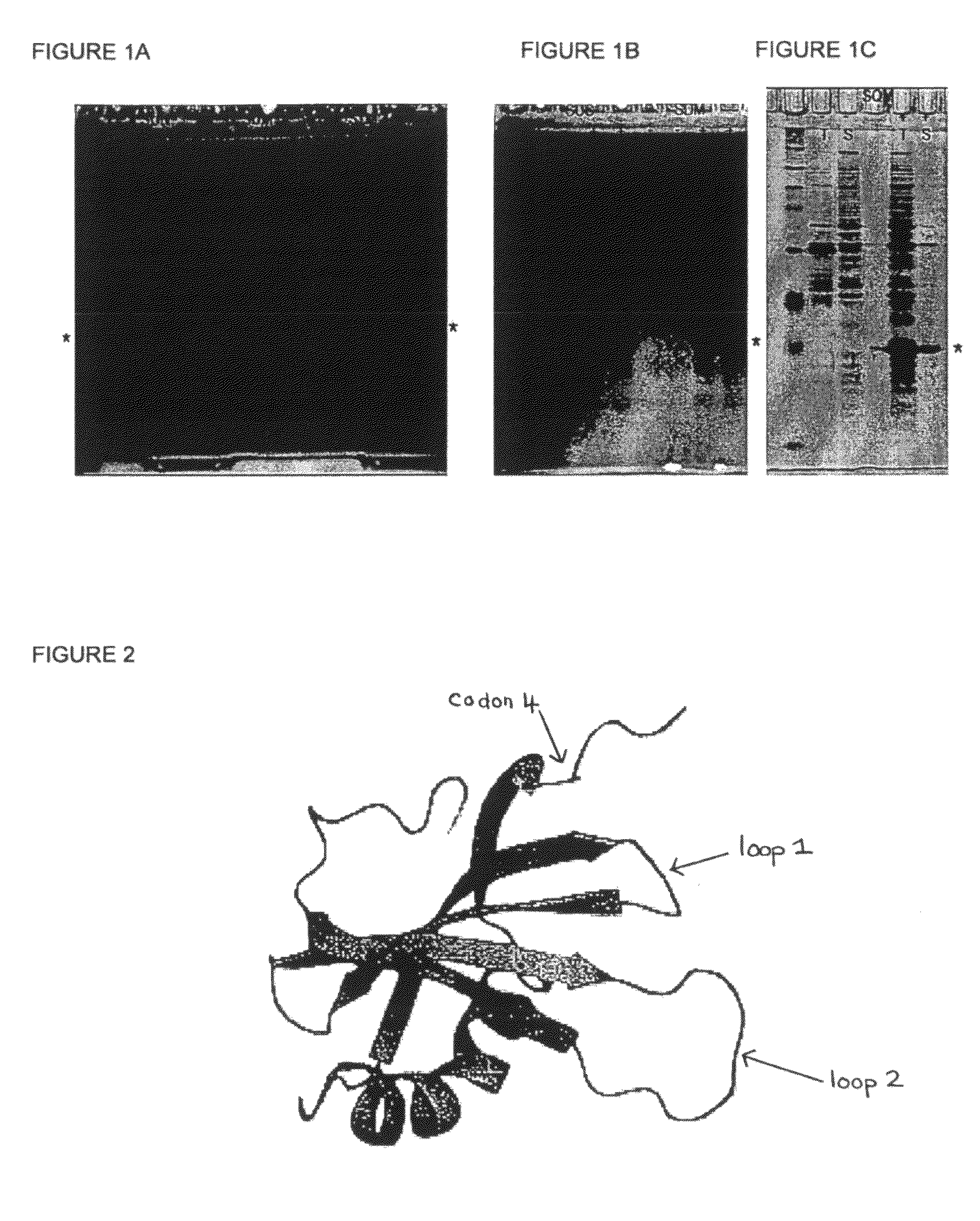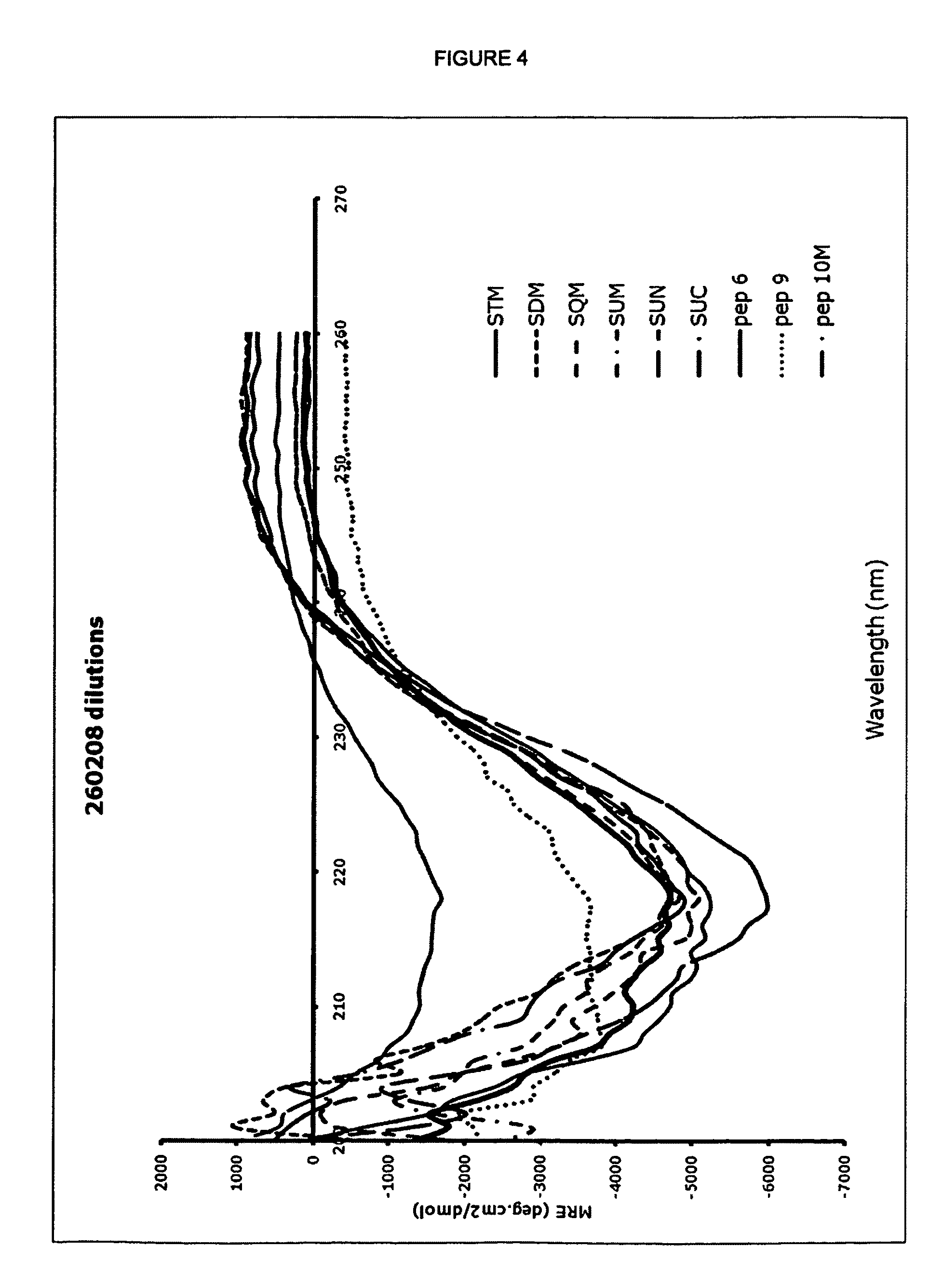Modified Stefin A scaffold proteins
a technology of stefin and scaffold proteins, which is applied in the field of modified stefin a scaffold proteins, can solve the problems of reducing the free energy of binding, limiting the interaction surface, and losing conformational entropy, and achieves the effect of facilitating conformational changes and conformational stability
- Summary
- Abstract
- Description
- Claims
- Application Information
AI Technical Summary
Benefits of technology
Problems solved by technology
Method used
Image
Examples
example 1
[0139]With reference to FIG. 2 there is shown a three dimensional structure of Stefin A and three sites in Stefin A which are mutated in order to generate the new scaffold proteins of the present invention. These sites are: at position G4 of Stefin A or W4 of STM; any of codons 46 to 54 inclusive of constraining loop 1 and particularly at codon positions 48-50; any of codons and; any of codons 67 to 84 inclusive of constraining loop 2 and particularly mutations of 70-73. Modified Stefin A or STM polypeptides for use as scaffold proteins are produced by mutating the sequence of Stefin A as described. The resulting proteins based on Stefin A but possessing the specified mutational changes are given in the sequences herein before disclosed.
example 2
[0140]FIG. 1 shows the expression of STM and exemplar variants in E coli. The open reading frames for STM and the variants disclosed herein were cloned into a version of the E coli expression vector pET30a+ which has been engineered to include additional functionalities in the amino terminal tail, such as a cysteine residue (present in all variants shown) or a StrepII tag (in STM only). The additional 8 amino acids of the inserted StrepII tag account for the slight difference in migration of the STM protein compared to the other variants. E coli cells carrying these expression constructs were grown in the absence (−) or the presence (+) of isoproptl-β-d-thiogalactopyranoside (IPTG), which induces the expression of STM and the variant proteins (highlighted by *). After 3 hours of induction at 37 C, cells were lysed by sonication, and the total cell lysate (T) or the soluble (S) portion recovered after a 10 minute centrifugation at 16,000×g were loaded onto 15% polyacrylamide gels. Pr...
example 3
[0141]In the production of new scaffold proteins based on Stefin A and / or STM a rational approach to the design of a new peptide has been employed. It is desirable for the new scaffold proteins of the present invention to possess qualities that an ideal scaffold would need to possess to be broadly useful for in vitro and in vivo studies and apply these criteria to the design of a new scaffold.
[0142]Starting from the small, stable intracellular protease inhibitor Stefin A or STM, we have engineered a number of biologically neutral scaffolds that retain the stable conformation of the parent protein. We expect that modified new scaffold proteins are able to present peptides that bind to targets of interest, both in the context of known interactors and in a library screen. Molecular tools based on the scaffolds find application in a wide range of studies of biological pathways, and in the validation of drug targets. SteA is a monomeric, single domain protein of 98 amino acids that recei...
PUM
| Property | Measurement | Unit |
|---|---|---|
| concentration | aaaaa | aaaaa |
| pH | aaaaa | aaaaa |
| pH | aaaaa | aaaaa |
Abstract
Description
Claims
Application Information
 Login to View More
Login to View More - R&D
- Intellectual Property
- Life Sciences
- Materials
- Tech Scout
- Unparalleled Data Quality
- Higher Quality Content
- 60% Fewer Hallucinations
Browse by: Latest US Patents, China's latest patents, Technical Efficacy Thesaurus, Application Domain, Technology Topic, Popular Technical Reports.
© 2025 PatSnap. All rights reserved.Legal|Privacy policy|Modern Slavery Act Transparency Statement|Sitemap|About US| Contact US: help@patsnap.com



